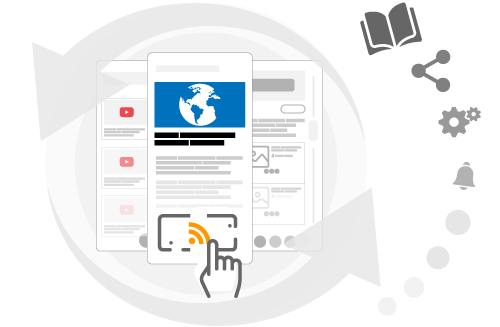» https://vk.
10/07/21 10:41 from Vk digest 2
» https://t.me/enacademicgroup/6143828
10/07/21 09:54 from Vk digest 2
» store.academic2.ru - urlscan.io
08/09/21 07:34 from Generated feed
Not observed on urlscan.io
Live Screenshot
Hover to expand
No direct hits
Nothing is hosted on this domain
No incoming hits
Nothing talked to this domain
DNS recordsRetrieved via DNS ANY query
| A |
138.201.81.43
(TTL: 3540)
|
| TXT |
wmail-verification: 6bc98baf4df82d6f3e56069a4d8488ee
|
| TXT |
yandex-verification: 11664def4b78652f
|
WHOIS for store.academic2.ru
domain: ACADEMIC2.RU
nserver: flamingo.ezoicns.com.
nserver: lionfish.ezoicns.com.
nserver: starfish.ezoicns.com.
state: REGISTERED, DELEGATED, VERIFIED
person: Private Person
registrar: RU-CENTER-RU
admin-contact: https://www.nic.ru/whois
created: 2019-08-09T01:22:10Z
paid-till: 2022-08-09T01:22:10Z
free-date: 2022-09-09
source: TCI
Last updated on 2022-06-14T21:51:30Z
Adblock test (Why?)
» Excel 2016: Sorting Data - GCFGlobal.org
09/09/21 23:12 from Publications digests filtered
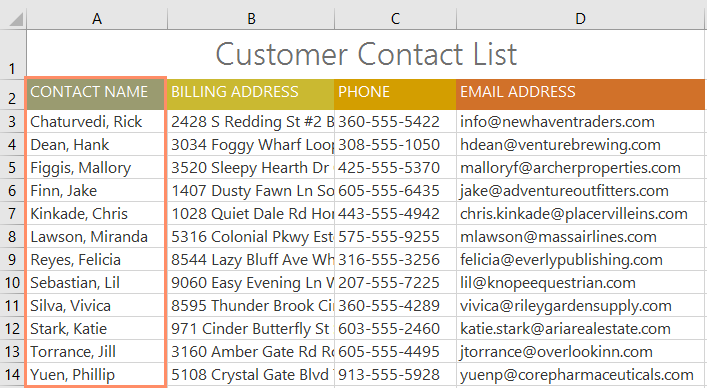
Types of sorting. When sorting data, it's important to first decide if you want the sort to apply to the entire worksheet or just a cell range.. Sort sheet organizes all of the data in your worksheet by one column. Related information across each row is kept together when the sort is applied.
Lesson 19: Sorting Data
/en/excel2016/freezing-panes-and-view-options/content/
Introduction
As you add more content to a worksheet, organizing this information becomes especially important. You can quickly
reorganize
a worksheet by
sorting
your data. For example, you could organize a list of contact information by last name. Content can be sorted alphabetically, numerically, and in many other ways.
Optional: Download our
practice workbook
.
Watch the video below to learn more about sorting data in Excel.
Types of sorting
When sorting data, it's important to first decide if you want the sort to apply to the
entire worksheet
or just a
cell range
.
-
Sort sheet
organizes all of the data in your worksheet by one column. Related information across each row is kept together when the sort is applied. In the example below, the
Contact Name
column (column
A
) has been sorted to display the names in alphabetical order.

-
Sort range
sorts the data in a range of cells, which can be helpful when working with a sheet that contains several tables. Sorting a range will not affect other content on the worksheet.
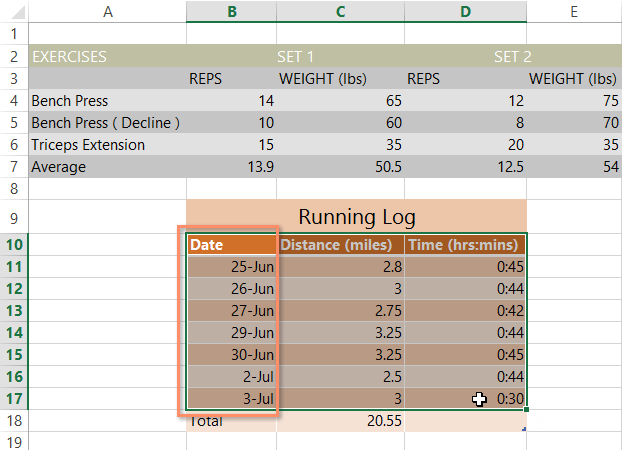
To sort a sheet:
In our example, we'll sort a T-shirt order form alphabetically by
Last Name
(column
C
).
-
Select a
cell
in the column you want to sort by. In our example, we'll select cell
C2
.

-
Select the
Data
tab on the
Ribbon
, then click the
A-Z command
to sort A to Z, or the
Z-A command
to sort Z to A. In our example, we'll sort A to Z.
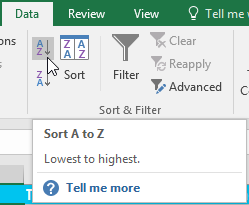
-
The worksheet will be
sorted
by the selected column. In our example, the worksheet is now sorted by
last name
.
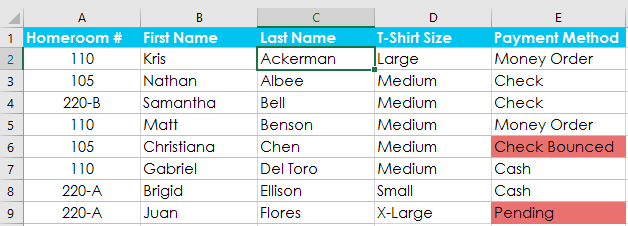
To sort a range:
In our example, we'll select a
separate table
in our T-shirt order form to sort the number of shirts that were ordered in each grade.
-
Select the
cell range
you want to sort. In our example, we'll select cell range
G2:H6
.

-
Select the
Data
tab on the
Ribbon
, then click the
Sort
command.
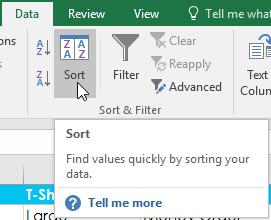
-
The
Sort
dialog box will appear. Choose the
column
you want to sort by. In our example, we want to sort the data by the number of T-shirt orders, so we'll select
Orders
.

-
Decide the
sorting order
(either ascending or descending). In our example, we'll use
Largest to Smallest
.
-
Once you're satisfied with your selection, click
OK
.

-
The cell range will be
sorted
by the selected column. In our example, the Orders column will be sorted from
highest to lowest
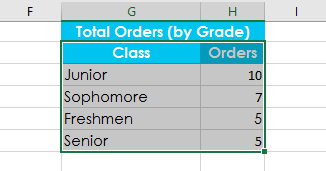
If your data isn't sorting properly, double-check your cell values to make sure they are entered into the worksheet correctly. Even a small typo could cause problems when sorting a large worksheet. In the example below, we forgot to include a hyphen in cell A18, causing our sort to be slightly inaccurate.
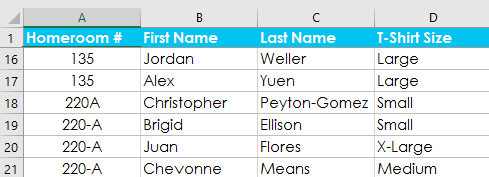
Custom sorting
Sometimes you may find that the default sorting options can't sort data in the order you need. Fortunately, Excel allows you to create a
custom list
to define your own sorting order.
To create a custom sort:
In our example below, we want to sort the worksheet by
T-Shirt Size
(column
D
). A regular sort would organize the sizes alphabetically, which would be incorrect. Instead, we'll create a custom list to sort from smallest to largest.
-
Select a
cell
in the column you want to sort by. In our example, we'll select cell
D2
.
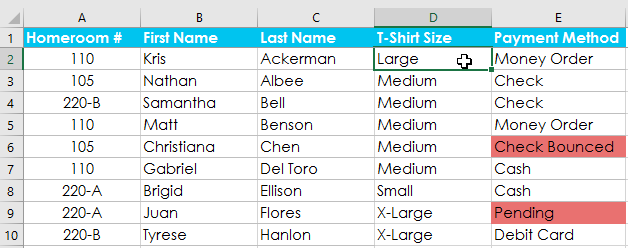
-
Select the
Data
tab, then click the
Sort
command.

-
The
Sort
dialog box will appear. Select the
column
you want to sort by, then choose
Custom List...
from the
Order
field. In our example, we will choose to sort by
T-Shirt Size
.
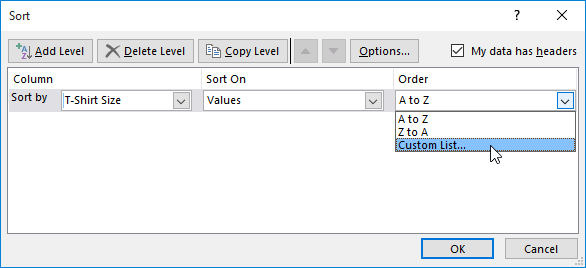
-
The
Custom Lists
dialog box will appear. Select
NEW LIST
from the
Custom Lists:
box.
-
Type the items in the desired custom order in the
List entries:
box. In our example, we want to sort our data by T-shirt size from
smallest
to
largest
, so we'll type
Small
,
Medium
,
Large
, and
X-Large
, pressing
Enter
on the keyboard after each item.
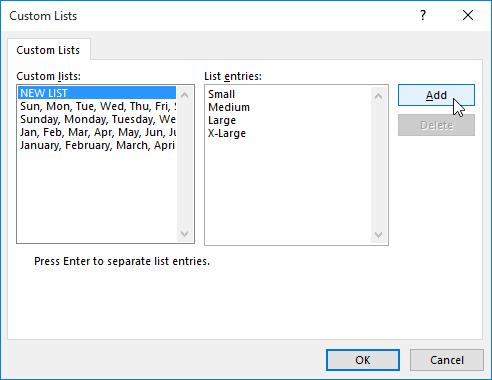
-
Click
Add
to save the new sort order. The new list will be added to the
Custom lists:
box. Make sure the new list is
selected
, then click
OK
.
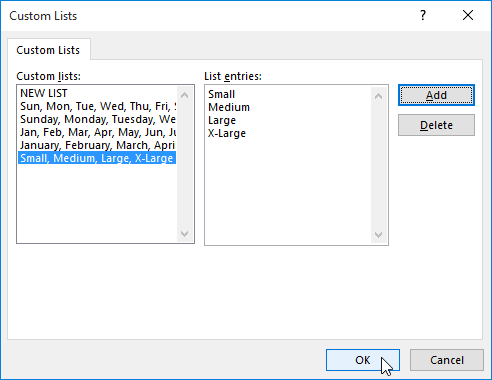
-
The
Custom Lists
dialog box will close. Click
OK
in the
Sort
dialog box to perform the custom sort.
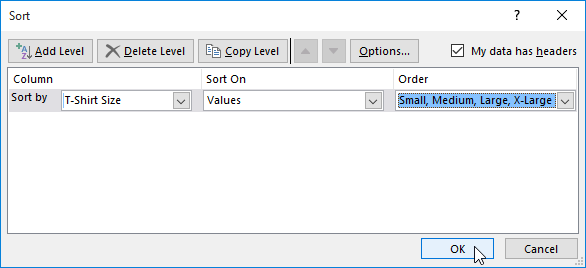
-
The worksheet will be
sorted
by the custom order. In our example, the worksheet is now organized by T-shirt size from smallest to largest.
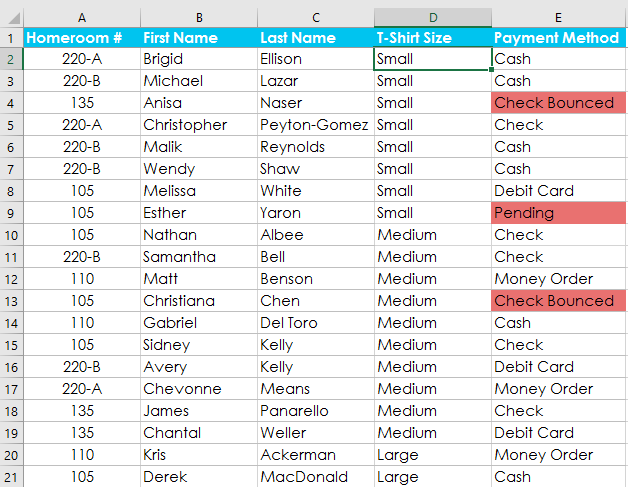
Sorting levels
If you need more control over how your data is sorted, you can add multiple
levels
to any sort. This allows you to sort your data by
more than one
column
.
To add a level:
In our example below, we'll sort the worksheet by
T-Shirt Size
(Column
D
), and then by
Homeroom Number
(column
A
).
-
Select a
cell
in the column you want to sort by. In our example, we'll select cell
A2
.
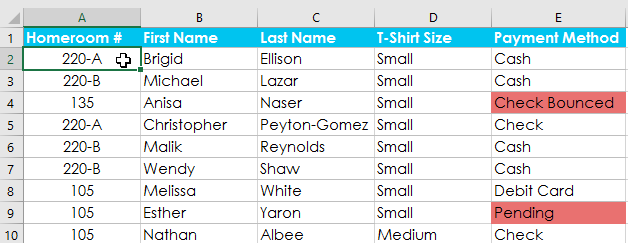
-
Click the
Data
tab, then select the
Sort
command.

-
The
Sort
dialog box will appear. Select the first column you want to sort by. In this example, we will sort by
T-Shirt Size
(column
D
) with the custom list we previously created for the Order field.
-
Click
Add Level
to add another column to sort by.
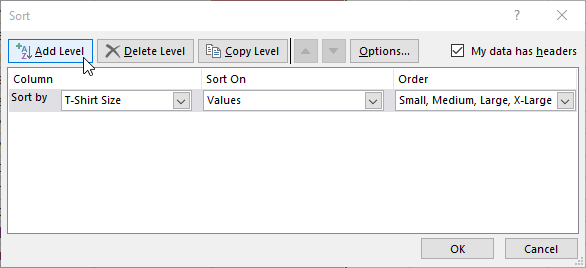
-
Select the next column you want to sort by, then click
OK
. In our example, we'll sort by
Homeroom #
A
).
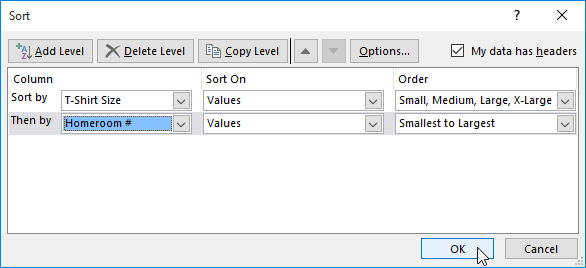
-
The worksheet will be
sorted
according to the selected order. In our example, the orders are sorted by T-shirt size. Within each group of T-shirt sizes, students are sorted by homeroom number.
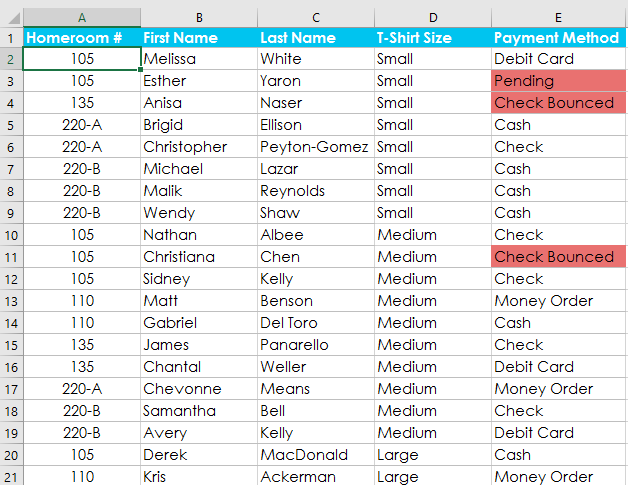
If you need to change the order of a multilevel sort, it's easy to control which column is sorted first. Simply select the desired
column
, then click the
Move Up
or
Move Down
arrow to adjust its priority.
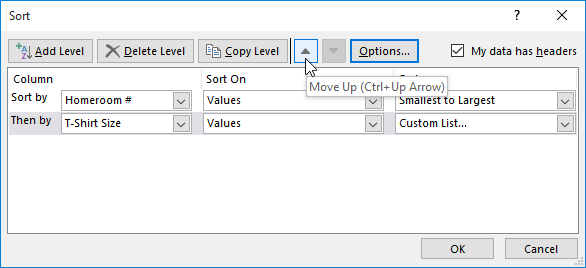
Challenge!
-
Open our
practice workbook
.
-
Click the
Challenge
tab in the bottom-left of the workbook.
-
For the main table, create a
custom sort
that sorts by
Grade
from
Smallest to Largest
and then by
Camper Name
from
A to Z
.
-
Create a sort for the
Additional Information
section. Sort by
Counselor (Column H)
from
A to Z
.
-
When you're finished, your workbook should look like this:

 Previous: Freezing Panes and View Options
Previous: Freezing Panes and View Options
/en/excel2016/filtering-data/content/
» Posts from together for 03/14/2020
11/09/21 12:01 from Analogindex Archive Feed
Posts from together for 03/14/2020
» Academic2 / ????²
10/07/21 02:25 from academic2.ru
% By submitting a query to RIPN's Whois Service
% you agree to
abide by the following terms of use:
%
http://www.ripn.net/about/servpol.html#3.2 (in Russian)
%
http://www.ripn.net/about/en/servpol.html#3.2 (in
English).domain: ACADEMIC2.RU
nserver:
ns1.masterhost.ru.
nserver: ns2.masterhost.ru.
nserver:
ns.masterhost.ru.
state: REGISTERED, DELEGATED,
VERIFIED
person: Private Person
registrar:
RU-CENTER-RU
admin-contact: https://www.nic.ru/whois
created:
2019-08-09T01:22:10Z
paid-till:
2020-08-09T01:22:10Z
free-date: 2020-09-09
source:
TCI
Last updated on 2020-03-14T21:36:32Z
» Store.academic2.ru - Store Academic2 outages, problems and current status. Store.academic2.ru website statistics.
06/09/21 23:06 from Generated feed
Store.academic2.ru is ranked #10 552 601 with 5 504 529 points. In the overall ranking store.academic2.ru ranks beside bimatnuoidaycon.com #10 552 600 with 5 504 530 points and banner.kingsnake.com #10 552 602 with 5 504 527 points. Store.academic2.ru receives approximately 278 daily, 8 340 monthly and more than 100 080 yearly unique visitors. The maximum number of daily hits can reach 311 and the minimum 231. Store.academic2.ru has a daily income of around US$ 1. Monthly income can reach up to US$ 30 and this is US$ 360 per annum. This site is estimated worth between US$ 540 and US$ 1 080. That exceeds worth of 23% of all analyzed sites.
10 552 601
Adblock test (Why?)
» academic2.ru - Academic2
11/09/21 20:52 from academic2.ru

academic2.ru - interrupções no Academic2, problemas e status atual. O que fazer se o academic2.ru estiver em baixo? A verificação de status atual do Academic2 já está em execução...
Academic2.ru - interrupções no Academic2, problemas e status atual. Academic2.ru estatísticas do site

academic2.ru — relatório geral de todos os tempos
|
Desde 24 de novembro de 2020:
|
|
Total de verificações
|
53
|
|
Em cima
|
53
|
|
Última vez em cima
|
08 de setembro de 2021
|
|
Tempo médio de resposta
|
0.195 sec
|
Detalhes dos pedidos nas últimas 24 horas
|
Total de verificações: 1
|
|
Estados Unidos
|
1
|
Histórico de estados do site nas últimas 24 horas
|
Verificar o tempo
|
Código de resposta
|
Estado
|
Tempo de resposta
|
|
20 h. 17 min. atrás
|
200
|
up
|
0.334 sec
|
Outra informação
